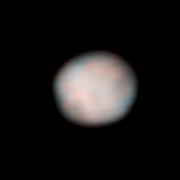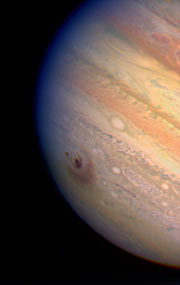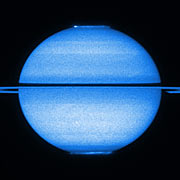The solar neighbourhood
 |
| Jupiter’s cloud bands with Io passing above and casting a shadow. |
Hubble's high resolution images of the planets and moons in our Solar System can only be surpassed by pictures taken from spacecraft that actually visit them. Hubble even has one advantage over these probes: it can look at these objects periodically and so observe them over much longer periods (years) than any passing probe could.
Hubble has observed all the planets in our Solar System, apart from Earth and Mercury. Earth is far better studied by geologists on the ground and specialised probes in orbit. Hubble can’t observe Mercury as it is too close to the Sun, whose brightness would damage the telescope’s sensitive instruments.
Our dynamic Solar System
 |
| The asteroid Vesta, captured by Hubble. This reveals details as small as 40km across. |
Regular monitoring of planetary surfaces is vital in the study of planetary atmospheres and geology, where evolving weather patterns such as dust storms can reveal much about the underlying processes. Hubble can also observe geological phenomena such as volcanic eruptions directly.
The asteroid Vesta is only 500 km in diameter and was surveyed by Hubble from a distance of 250 million km. The resulting map of the surface shows a strange world with possibly ancient lava flows, as well as a gigantic impact crater. Hubble has even able to capture the asteroid’s changing appearance as it rotates.
 |
| Impact site of one of the fragments of comet Shoemaker-Levy 9 |
In comparison with probes that have to travel vast distances and require years of planning to visit the planets Hubble is also able to react quickly to sudden dramatic events occurring in the Solar System. This allowed it to witness the stunning plunge of comet Shoemaker-Levy 9 into Jupiter’s atmosphere during the period 16-22 July 1994.
Hubble followed the comet fragments on their last journey and delivered incredible high-resolution images of the impact scars, from which important new information on conditions in the Jovian atmosphere was obtained.
The consequences of the impact could be seen for several days afterwards, and by studying the Hubble data astronomers were able to gain fundamental information about the composition and density of the giant planet’s atmosphere. Since the impact of Shoemaker-Levy 9, Hubble has continued to study impacts, events and changes on Jupiter, improving our understanding of the Solar System’s largest planet.
Hubble also observed the spectacular break up of comet 73P/Schwassmann-Wachmann 3 as it visited the inner Solar System, the asteroid collision P2010/A2 and a mysterious disintegrating asteroid.
|
"We conducted an intensive series of observations of Pluto with Hubble followed by advanced data processing on the ground. We saw surface features emerge for the first time in history on our screens. For me, personally, it was a memorable experience to be able to show this image to the original discoverer of Pluto, Clyde Tombaugh, and in this way let Hubble pay a tribute to his great discovery." Rudi Albrecht |
The Aurorae of Jupiter and Saturn
 |
| In early 2009, Saturn was visible side-on from Earth, letting Hubble capture this unique image of aurorae at both poles. |
Hubble's extremely high resolution and sensitivity have made unique observations of objects within the Solar System possible - amazing images and rich amounts of data about the nature of these objects have been obtained. Hubble has seen unprecedented detail in Jupiter’s aurorae. These aurorae are similar to those seen above the Earth's Polar Regions, but are almost 1000 times more energetic and much more complex. Aurorae can be seen at both Jupiter’s poles - but only in ultraviolet light, so they could have not been observed with any ground-based telescope.
Astonishing images of Saturn’s auroras were also taken in ultraviolet light and reveal exquisite new details. The spectacular auroral curtains of ultraviolet light that encircle Saturn’s north and south poles rise more than a thousand miles above the cloud tops.
Long distance, long term observations
 |
| Pluto and its moon Charon. |
Hubble's high resolution images are naturally surpassed by pictures taken from planetary probes that actually visit the planets, but Hubble has the advantage of being able to carry out long-term monitoring and can return to look at these objects periodically. This is crucial for the study of planetary atmospheres and geology.
Hubble regularly observes the global seasonal dust storms on Mars, producing astonishing high resolution images.
Unlike the planets in our Solar System, the dwarf planet Pluto has not yet been visited by a probe, but in 1994 Hubble made the first clear images showing Pluto and its moon Charon as separate objects from a distance of 4.4 billion kilometres. In addition Hubble discovered several new moons as well as a dwarf planet beyond Pluto, which led to the discussion of Pluto being a planet.
Related images and videos
- Hubblecast episode 27: What has Hubble taught us about the planets?
- Images of Neptune
- Images of Uranus
- Images of Saturn
- Images of Jupiter
- Images of Mars
- Images of Venus
Related news releases
- Hubble provides spectacular view of comet breakup (2006)
- Saturn’s aurorae offer stunning double show (2009)
- Hubble captures rare Jupiter collision (2009)
- Hubble finds that a bizarre x-shaped intruder is linked to an unseen asteroid collision (2010)
- Hubble discovers new Pluto moon (2012)
- Hubble witnesses an asteroid mysteriously disintegrating (2014)
- The shrinking of Jupiter's Great Red Spot (2014)
- Hubble observes chaotic dance of Pluto's moons (2015)
- Vivid aurorae on Jupiter (2016)
- Hubble discovers a unique type of object in the Solar System (2017)
- Hubble sees `Oumuamua getting a boost (2018)